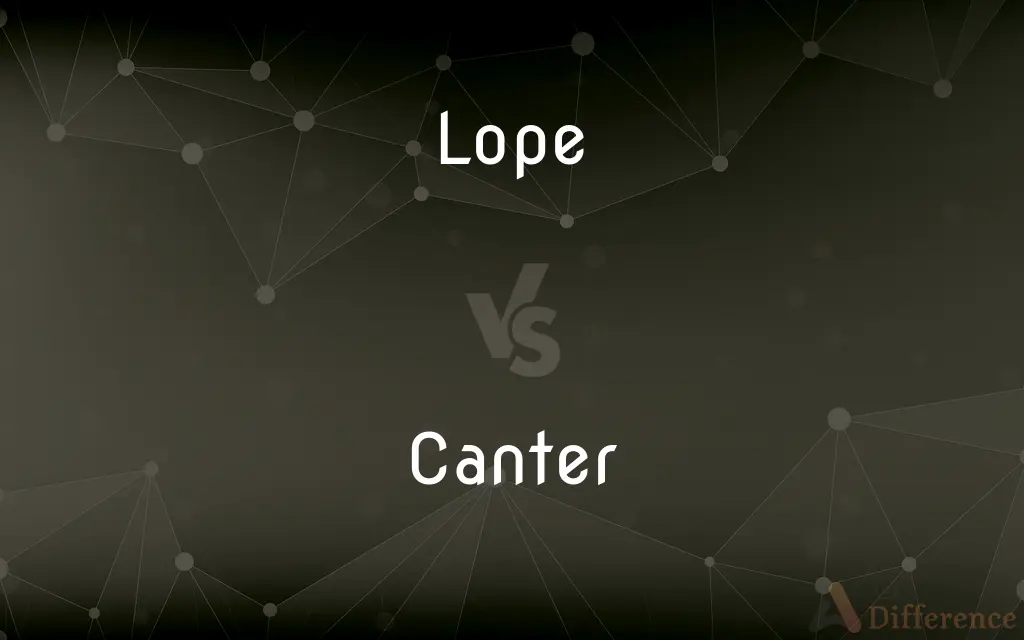Lope vs. Canter — What's the Difference?
By Tayyaba Rehman & Maham Liaqat — Updated on April 16, 2024
Lope and canter refer to similar three-beat gaits in horse riding, but lope is generally slower and smoother, used in Western riding, while canter is a bit faster and more formal, commonly seen in English riding.

Difference Between Lope and Canter
Table of Contents
ADVERTISEMENT
Key Differences
In Western riding, the lope is characterized by a relaxed, smooth gait that covers ground efficiently without much vertical movement, making it comfortable for long rides. Conversely, the canter, prevalent in English riding, is slightly quicker and has more spring and lift, which can be essential for various English disciplines like jumping and dressage.
The lope is often described as more natural and less structured, focusing on comfort and ease, which suits the informal and practical nature of Western riding. In contrast, the canter is more controlled and can vary in speed and formality, fitting the precise and varied requirements of English riding competitions.
Riders at a lope typically sit back more in the saddle with a relaxed posture, reflecting the casual style of Western riding. Meanwhile, during a canter, riders maintain a more upright posture and are often required to post or adjust their seat actively, especially in competitive contexts.
The training for achieving a good lope versus a good canter also differs; Western horses are trained to lope with minimal aid and maintain the gait steadily, whereas English horses are trained to respond to more nuanced commands to adjust the canter’s pace and collection.
The choice between lope and canter not only reflects the riding style but also influences tack and riding techniques, with Western saddles designed for comfort and endurance at a lope, and English saddles designed to facilitate balance and control at a canter.
ADVERTISEMENT
Comparison Chart
Riding Style
Western riding
English riding
Speed
Generally slower and smoother
Slightly faster with more lift
Rider's Posture
Relaxed, sitting back in the saddle
More upright, active posting required
Training Focus
Minimal aids, steady gait
Nuanced commands, adjustable pace
Suitable Disciplines
Trail riding, Western pleasure
Jumping, dressage, eventing
Compare with Definitions
Lope
Known for its natural, relaxed rhythm that is easy on both horse and rider.
He trained his horse to maintain a steady lope without constant commands.
Canter
Used extensively in competitive and formal riding contexts.
The dressage test included several complex maneuvers at the canter.
Lope
Often associated with a laid-back riding style.
The relaxed lope was perfect for the casual trail ride.
Canter
A controlled, three-beat gait that is common in English riding disciplines.
She practiced the canter in the arena to prepare for the jumping competition.
Lope
Emphasizes the horse's ability to carry a rider smoothly and effortlessly.
Her horse’s lope was so smooth, it felt like gliding.
Canter
Can vary in speed, but generally has more vertical movement and lift than the lope.
The horse moved into a spirited canter as they approached the first jump.
Lope
Ideal for long distances, providing comfort and endurance.
The long trail was perfect for a long, relaxing lope.
Canter
Requires more active rider engagement to manage the pace and form.
He adjusted his seat to maintain a balanced canter around the tight corner.
Lope
A smooth, three-beat gait of a horse that is slower than a gallop but faster than a trot, commonly used in Western riding.
The cowboy enjoyed a gentle lope across the open field.
Canter
Associated with precise, disciplined training and riding.
Perfecting the canter took hours of focused training in the saddle.
Lope
To run or ride with a steady, easy gait.
Canter
A pace of a horse or other quadruped between a trot and a gallop, with not less than one foot on the ground at any time
I rode away at a canter
Lope
A steady, easy gait.
Canter
(of a horse) move at a canter in a particular direction
They cantered down into the village
Lope
To travel an easy pace with long strides.
He loped along, hour after hour, not fast but steady and covering much ground.
Canter
A smooth three-beat gait of a horse that is slower than a gallop but faster than a trot, in which the feet touch the ground in the three-beat sequence of near hind foot, off hind foot and near front foot, off front foot.
Lope
To jump, leap.
Canter
A ride on a horse moving with this gait.
Lope
An easy pace with long strides.
Canter
To go or move at a canter.
Lope
Of Leap.
And, laughing, lope into a tree. Spenser.
Canter
To cause (a horse) to go at a canter.
Lope
To leap; to dance.
Canter
A gait of a horse between a trot and a gallop, consisting of three beats and a "suspension" phase, where there are no feet on the ground. Also describing this gait on other four legged animals.
Lope
To move with a leaping or bounding stride, as a horse.
Canter
A ride on a horse at such speed.
Lope
To run with an easy, bounding stride; - of people.
Canter
One who cants or whines; a beggar.
Lope
A leap; a long step.
Canter
One who makes hypocritical pretensions to goodness; one who uses canting language.
Lope
An easy gait, consisting of long running strides or leaps.
The mustang goes rollicking ahead, with the eternal lope, . . . a mixture of two or three gaits, as easy as the motions of a cradle.
Canter
(intransitive) To move at such pace.
Lope
A slow pace of running
Canter
(transitive) To cause to move at a canter; to ride (a horse) at a canter.
Lope
A smooth 3-beat gait; between a trot and a gallop
Canter
A moderate and easy gallop adapted to pleasure riding.
Lope
Run easily
Canter
A rapid or easy passing over.
A rapid canter in the Times over all the topics.
Canter
One who cants or whines; a beggar.
Canter
One who makes hypocritical pretensions to goodness; one who uses canting language.
The day when he was a canter and a rebel.
Canter
To move in a canter.
Canter
To cause, as a horse, to go at a canter; to ride (a horse) at a canter.
Canter
A smooth 3-beat gait; between a trot and a gallop
Canter
Ride at a canter;
The men cantered away
Canter
Go at a canter, of horses
Canter
Ride at a cantering pace;
He cantered the horse across the meadow
Common Curiosities
What type of saddle is best for cantering?
For cantering, an English saddle is typically best as it allows for better control and balance during the faster, more lifted gait.
What is the main difference between lope and canter?
The main difference is that lope is a smoother, slower gait used in Western riding, while canter is a bit faster with more lift, used in English riding.
Why might a rider choose to lope instead of trot?
A rider might choose to lope instead of trot for greater comfort over long distances, as loping is smoother and less jarring than trotting.
Can all horses lope and canter?
Yes, most healthy horses can be trained to perform both gaits, though the ease and style of each will depend on the horse’s training and natural disposition.
Are there competitions that involve loping?
Yes, there are Western riding competitions that involve loping, particularly in events like Western pleasure where the quality and smoothness of the lope are judged.
Is the lope or canter easier for beginners to learn?
Beginners might find the lope easier to learn due to its smoothness and the generally more relaxed riding style of Western disciplines.
Can you switch directly from a lope to a gallop?
Yes, a rider can transition from a lope to a gallop, typically by increasing the speed and cueing the horse to extend its stride.
How do I train my horse to lope?
Training a horse to lope involves encouraging a relaxed, steady rhythm and using minimal riding aids to maintain a comfortable speed.
What should I focus on when cantering in a dressage test?
Focus on maintaining rhythm, balance, and precise control of the horse’s movement and speed during a dressage test.
How does tack influence the horse’s ability to lope or canter?
The design of the tack, especially the saddle, affects the horse's comfort and the rider's control during these gaits. Western saddles support the smooth, enduring lope, while English saddles facilitate the dynamic, controlled canter.
Share Your Discovery

Previous Comparison
Series vs. Title
Next Comparison
Obesity vs. AdiposityAuthor Spotlight
Written by
Tayyaba RehmanTayyaba Rehman is a distinguished writer, currently serving as a primary contributor to askdifference.com. As a researcher in semantics and etymology, Tayyaba's passion for the complexity of languages and their distinctions has found a perfect home on the platform. Tayyaba delves into the intricacies of language, distinguishing between commonly confused words and phrases, thereby providing clarity for readers worldwide.
Co-written by
Maham Liaqat















































